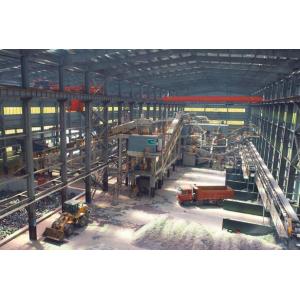Supplier: Hunan RE Technology CO.,LTD
Contact person: Mr. Liu Wei
Position:
Address: Building.10, Liandong U Valley Industrial Park, Yuelu District
Country: China
Phone: - Mobi: 18207409461
Oxygen Enriched Side Blown Furnace
Price:
As the demand for lithium-ion batteries (Li-ion) continues to grow, especially in electric vehicles (EVs), consumer electronics, and renewable energy storage, the need for efficient recycling processes has become increasingly important. Lithium battery recycling production lines are designed to recover valuable materials from used batteries, reducing environmental impact and providing a sustainable source of raw materials for new batteries.
How a Lithium Battery Recycling Production Line Works
Collection and Sorting
Collection: Used batteries are collected from various sources, including EVs, consumer electronics, and industrial applications.
Sorting: Batteries are sorted based on their chemistry (e.g., lithium cobalt oxide, lithium iron phosphate) and condition. This step is crucial because different battery chemistries require different recycling processes.
Discharging
Safe Discharge: To prevent fires or explosions during processing, batteries are fully discharged in a controlled environment. This step neutralizes the electrical energy stored in the batteries, making them safe for further handling.
Shredding and Size Reduction
Mechanical Shredding: Batteries are mechanically shredded into smaller pieces, breaking down the battery cells into fragments. This process separates the battery components such as the casing, electrodes, electrolyte, and separator materials.
Size Reduction: Additional milling or grinding processes may be employed to further reduce the size of the particles, enhancing the efficiency of subsequent separation steps.
Separation and Extraction
Magnetic Separation: Magnets are used to separate ferrous materials, such as steel casings, from non-ferrous components.
Hydrometallurgical Processing: Involves chemical leaching to dissolve and extract valuable metals like lithium, cobalt, nickel, and manganese from the shredded battery materials. The resulting solution is processed to recover these metals as salts or oxides.
Pyrometallurgical Processing: High-temperature furnaces are used to smelt the shredded material, recovering metals in a more concentrated form. This process is often used for recovering cobalt, nickel, and copper.
Purification and Refining
Precipitation and Filtration: The dissolved metals are precipitated out of the solution, filtered, and purified. This step may involve multiple stages of refining to achieve high-purity metal compounds suitable for reuse in new batteries.
Electrolysis: Metals like lithium can be further purified through electrolysis, where an electric current is used to deposit pure metal onto electrodes.
Recovery of Non-Metallic Materials
Plastics and Electrolytes: The plastics and separator materials are typically separated through flotation or solvent extraction techniques. These materials can be recycled into new products or safely disposed of.
Graphite Recovery: Anode materials, often composed of graphite, can be recovered and processed for reuse in new battery anodes.
lithium battery recycling plant Advantage:
1. Realization of charged crushing process
2. Low-temperature evaporation of electrolyte for harmless disposal
3. Diaphragm Clean Recovery
4. Highly efficient recovery of polar powders
5. High-precision color sorting
6. Zero discharge of production wastewater
7. Exhaust gas centralized treatment, discharge up to standard
8. Harmless recycling of fluorine
How a Lithium Battery Recycling Production Line Works
Collection and Sorting
Collection: Used batteries are collected from various sources, including EVs, consumer electronics, and industrial applications.
Sorting: Batteries are sorted based on their chemistry (e.g., lithium cobalt oxide, lithium iron phosphate) and condition. This step is crucial because different battery chemistries require different recycling processes.
Discharging
Safe Discharge: To prevent fires or explosions during processing, batteries are fully discharged in a controlled environment. This step neutralizes the electrical energy stored in the batteries, making them safe for further handling.
Shredding and Size Reduction
Mechanical Shredding: Batteries are mechanically shredded into smaller pieces, breaking down the battery cells into fragments. This process separates the battery components such as the casing, electrodes, electrolyte, and separator materials.
Size Reduction: Additional milling or grinding processes may be employed to further reduce the size of the particles, enhancing the efficiency of subsequent separation steps.
Separation and Extraction
Magnetic Separation: Magnets are used to separate ferrous materials, such as steel casings, from non-ferrous components.
Hydrometallurgical Processing: Involves chemical leaching to dissolve and extract valuable metals like lithium, cobalt, nickel, and manganese from the shredded battery materials. The resulting solution is processed to recover these metals as salts or oxides.
Pyrometallurgical Processing: High-temperature furnaces are used to smelt the shredded material, recovering metals in a more concentrated form. This process is often used for recovering cobalt, nickel, and copper.
Purification and Refining
Precipitation and Filtration: The dissolved metals are precipitated out of the solution, filtered, and purified. This step may involve multiple stages of refining to achieve high-purity metal compounds suitable for reuse in new batteries.
Electrolysis: Metals like lithium can be further purified through electrolysis, where an electric current is used to deposit pure metal onto electrodes.
Recovery of Non-Metallic Materials
Plastics and Electrolytes: The plastics and separator materials are typically separated through flotation or solvent extraction techniques. These materials can be recycled into new products or safely disposed of.
Graphite Recovery: Anode materials, often composed of graphite, can be recovered and processed for reuse in new battery anodes.
lithium battery recycling plant Advantage:
1. Realization of charged crushing process
2. Low-temperature evaporation of electrolyte for harmless disposal
3. Diaphragm Clean Recovery
4. Highly efficient recovery of polar powders
5. High-precision color sorting
6. Zero discharge of production wastewater
7. Exhaust gas centralized treatment, discharge up to standard
8. Harmless recycling of fluorine
SEND INQUIRY
Please fill in fully your information to send email
CATEGORY














 Agriculture
Agriculture